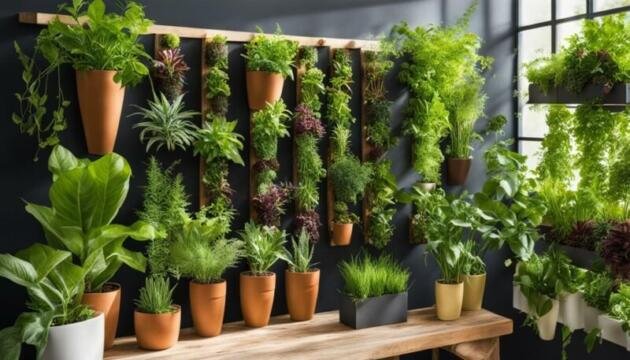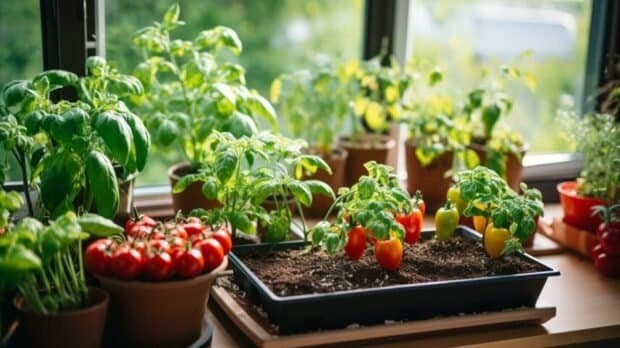Discover How to Save Money with Indoor Hydroponics
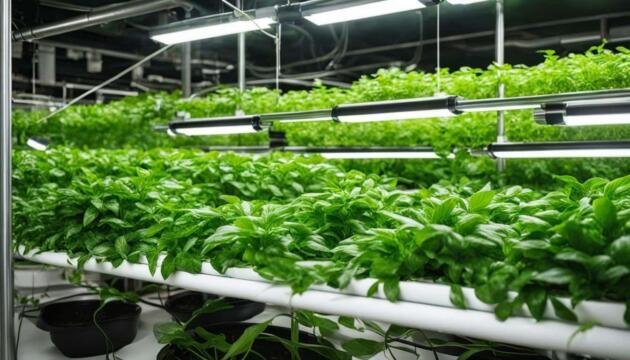
Are you tired of spending a fortune on fresh produce at the grocery store? Did you know that you can save money by growing your own fruits and vegetables at home? With indoor hydroponics, you can enjoy fresh, homegrown produce all year while reducing your grocery expenses. Indoor hydroponic systems offer a sustainable and cost-effective solution for anyone looking to save money and eat healthier.
- Indoor hydroponics can help you save money on fresh produce.
- Indoor hydroponic systems offer a sustainable and cost-effective solution.
- You can enjoy fresh, homegrown produce all year.
- Indoor hydroponics is a great way to reduce your grocery expenses.
- Start growing your own fruits and vegetables at home with indoor hydroponics.
Understanding Indoor Hydroponics: A Sustainable Solution
If you’re interested in gardening but lack outdoor space or live in a climate with limited growing seasons, hydroponic gardening is an innovative solution for you. With hydroponic gardening, you can grow plants indoors year-round without soil and without the use of harmful pesticides.
The benefits of hydroponic gardening extend beyond convenience. Hydroponic plants grow faster and produce higher yields than traditionally grown plants, making them an excellent solution for those looking to save money on groceries. Hydroponic gardening also uses less water than traditional gardening methods, making it an environmentally sustainable option.
So, how does hydroponic gardening work? Instead of growing plants in soil, hydroponic gardening involves growing them in a nutrient-rich water solution. By providing plants with all the necessary nutrients they need in a controlled environment, hydroponic gardening allows for faster and healthier growth.
Grow Plants Indoors
One of the most significant advantages of hydroponic gardening is the ability to grow plants indoors, regardless of the outdoor weather conditions. By growing plants indoors, you can control the temperature, humidity, and light levels, providing optimal conditions for your plants to thrive.
Another benefit of indoor hydroponic gardening is the ability to grow a wider variety of plants than traditional gardening methods would allow. With hydroponic gardening, you can grow anything from herbs and leafy greens to tomatoes and peppers, all from the comfort of your own home.
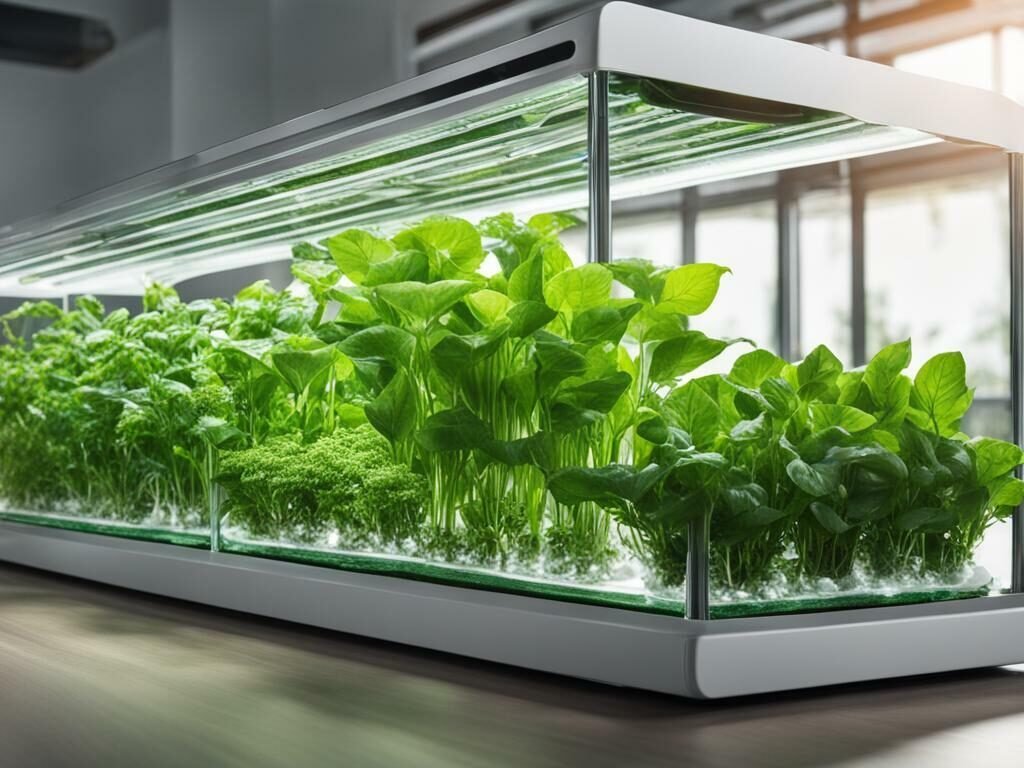
Hydroponic gardening equipment is also relatively compact, making it ideal for small spaces such as apartments or urban environments. With a small setup, it is possible to grow all the fresh produce you need for a healthy, balanced diet.
As you can see, hydroponic gardening offers many benefits for those looking to grow plants indoors sustainably and economically. In the following sections, we’ll delve into more detail about how to get started with hydroponic gardening, essential hydroponic nutrients, and how to maintain your indoor hydroponic system.
Getting Started with Indoor Hydroponics
Indoor gardening has gained popularity in recent years as a sustainable and cost-effective way of growing your own food. Hydroponic gardening, in particular, has become a popular method for indoor gardening due to its efficiency and high yield. If you’re interested in starting your own indoor hydroponic garden, here are some tips to help you get started.
Choosing the Right Location
One of the first things to consider when setting up your indoor hydroponic garden is choosing the right location. You’ll want to select a space that receives plenty of natural light or invest in grow lights to ensure your plants receive adequate light. The space should also have good ventilation to prevent the buildup of humidity and mold.
Setting up the Necessary Equipment
Setting up your indoor hydroponic system requires some basic equipment, such as a grow tray, grow lights, nutrient reservoir, air pump, and pH meter. When selecting your equipment, it’s important to consider the size of your space and the number of plants you plan to grow. You’ll also want to choose high-quality equipment to ensure the longevity of your system.
Providing Optimal Conditions for Plant Growth
Consistent monitoring and optimization of conditions are crucial to the success of your indoor hydroponic garden. This includes maintaining the correct nutrient levels and pH balance, ensuring adequate air circulation and moisture, and preventing pest infestations.
- Regularly test the pH level of your nutrient solution using a pH meter
- Ensure proper air circulation and humidity levels with fans or humidifiers
- Prevent pest infestations by keeping your space clean and using natural pest control methods such as companion planting or neem oil
By following these indoor gardening tips, you can create a healthy and thriving indoor hydroponic garden that will provide you with fresh, nutrient-dense produce year-round.
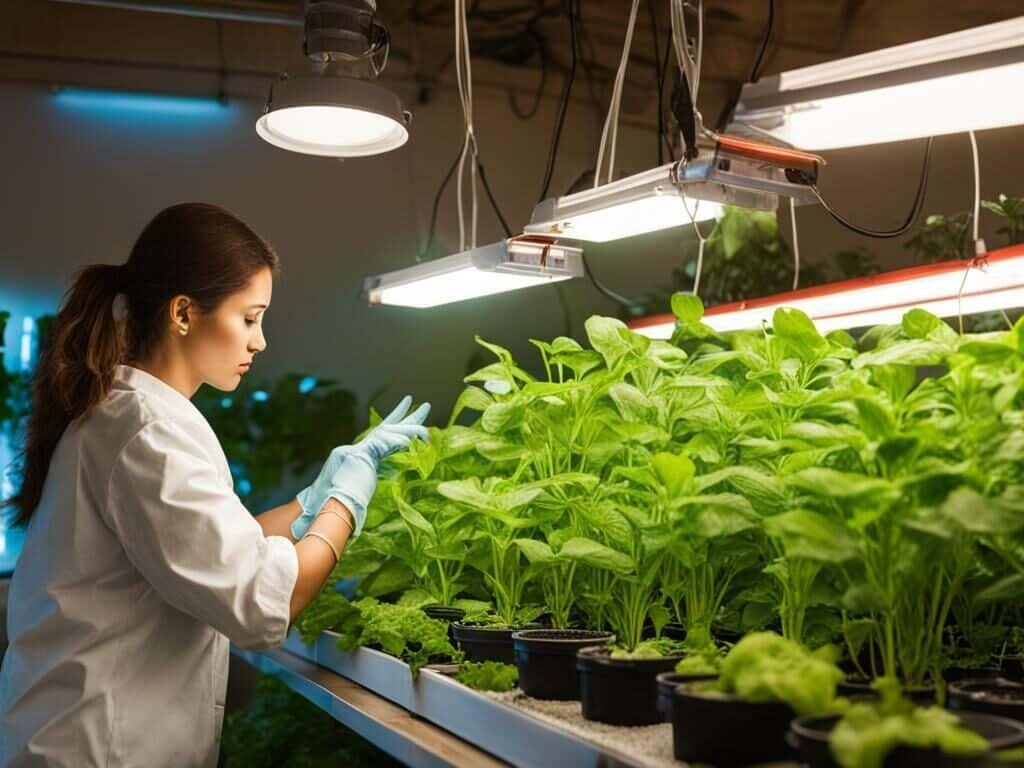
Essential Hydroponic Nutrients for Healthy Plants
Hydroponic gardening is a soil-free method of growing plants indoors. In this method, plants are grown in a nutrient-rich solution, ensuring they receive all the necessary nutrients for healthy growth. Choosing the right hydroponic nutrients is crucial to the success of your indoor hydroponic garden.
The Importance of Hydroponic Nutrients
Without soil, plants are unable to access the nutrients they need to grow. In hydroponic gardening, these nutrients are added to the water to create a nutrient-rich solution. The three essential macronutrients required for plant growth are nitrogen, phosphorus, and potassium. In addition, plants also require micronutrients such as calcium, magnesium, and iron.
To ensure your plants receive all the necessary nutrients, it’s important to choose a high-quality hydroponic nutrient solution that contains the correct balance of macronutrients and micronutrients. It’s also important to monitor nutrient levels regularly to avoid deficiencies or excesses that can harm your plants.
Types of Hydroponic Nutrients
There are two main types of hydroponic nutrients: liquid and powdered. Liquid nutrients are pre-mixed and ready to use, while powdered nutrients need to be mixed with water before use. Both types come in a range of formulas designed for different stages of plant growth.
When choosing a hydroponic nutrient solution, consider the specific needs of your plants and the stage of growth they are in. It’s also important to choose a pH-balanced solution that matches the pH of your water source.
Nutrient Management and Deficiency Prevention
To ensure your plants remain healthy and productive, it’s important to manage nutrient levels and prevent nutrient deficiencies. This involves monitoring nutrient levels regularly and adjusting the nutrient solution as needed.
Common nutrient deficiencies in hydroponic gardening include nitrogen deficiency, which can cause stunted growth, yellowing leaves, and poor fruit production, and iron deficiency, which can cause yellowing between the leaf veins. To prevent nutrient deficiencies, it’s important to follow the manufacturer’s instructions and monitor nutrient levels regularly.
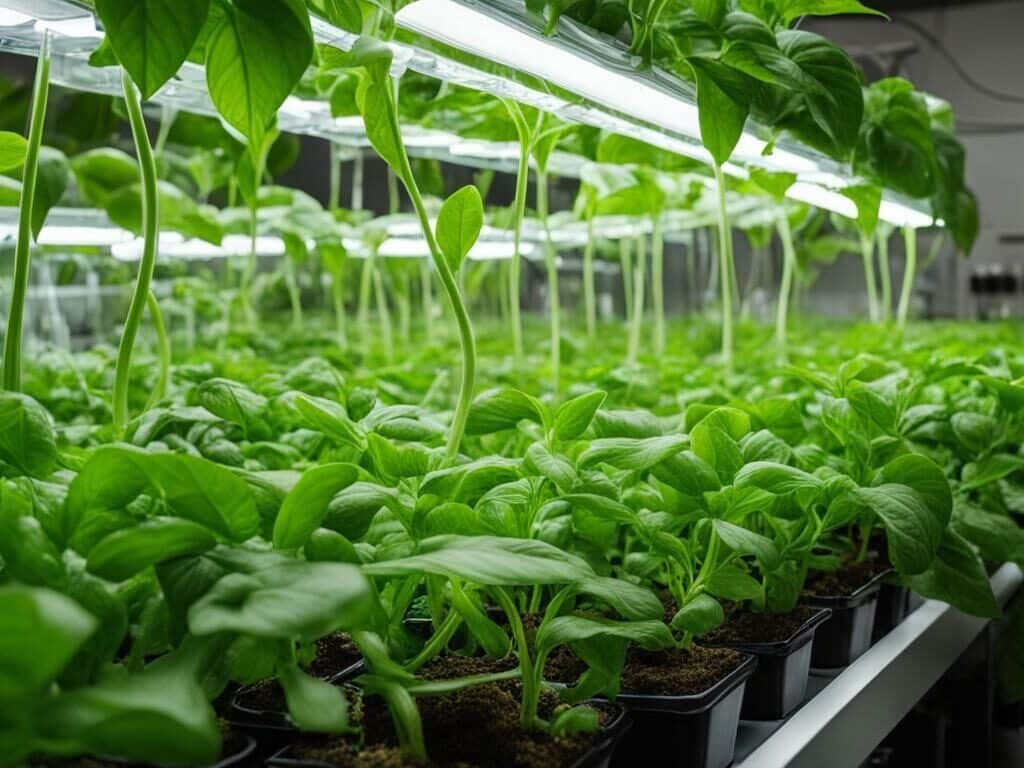
“Choosing the right hydroponic nutrients is crucial to the success of your indoor hydroponic garden.”
Choosing the Right Hydroponic Supplies
When it comes to indoor hydroponics, having the right supplies is essential for optimal plant growth and harvest. Here are some of the key hydroponic supplies you’ll need:
- Growing medium: Unlike traditional soil gardening, hydroponics relies on a soil-less growing medium such as rockwool, coconut coir, or perlite. Make sure to choose a medium that is appropriate for your plants’ needs.
- Hydroponic system: There are several types of hydroponic systems to choose from, such as deepwater culture, nutrient film technique, and drip irrigation. Consider your space, budget, and the types of plants you want to grow when selecting your system.
- Grow lights: Since indoor hydroponics lacks the natural sunlight found in outdoor gardening, grow lights are essential for providing your plants with the necessary light spectrum. LED grow lights are energy-efficient and emit less heat than traditional options.
- Nutrients: Hydroponic plants require a specific blend of nutrients to thrive. Choose a nutrient solution that matches the growth stage of your plants, and avoid overfeeding or underfeeding.
- pH and EC meters: Monitoring the pH and electrical conductivity (EC) of your water solution is critical to ensuring proper nutrient uptake and plant health. Invest in a reliable meter to avoid nutrient imbalances.
- Timers and pumps: Depending on your hydroponic system, you may need pumps and timers to regulate water flow and nutrient distribution.
Investing in quality hydroponic supplies may seem costly at first, but the long-term savings on groceries and the satisfaction of growing your own food make it a worthwhile investment. Check out the image below to see some of the common hydroponic supplies you’ll want to have on hand.
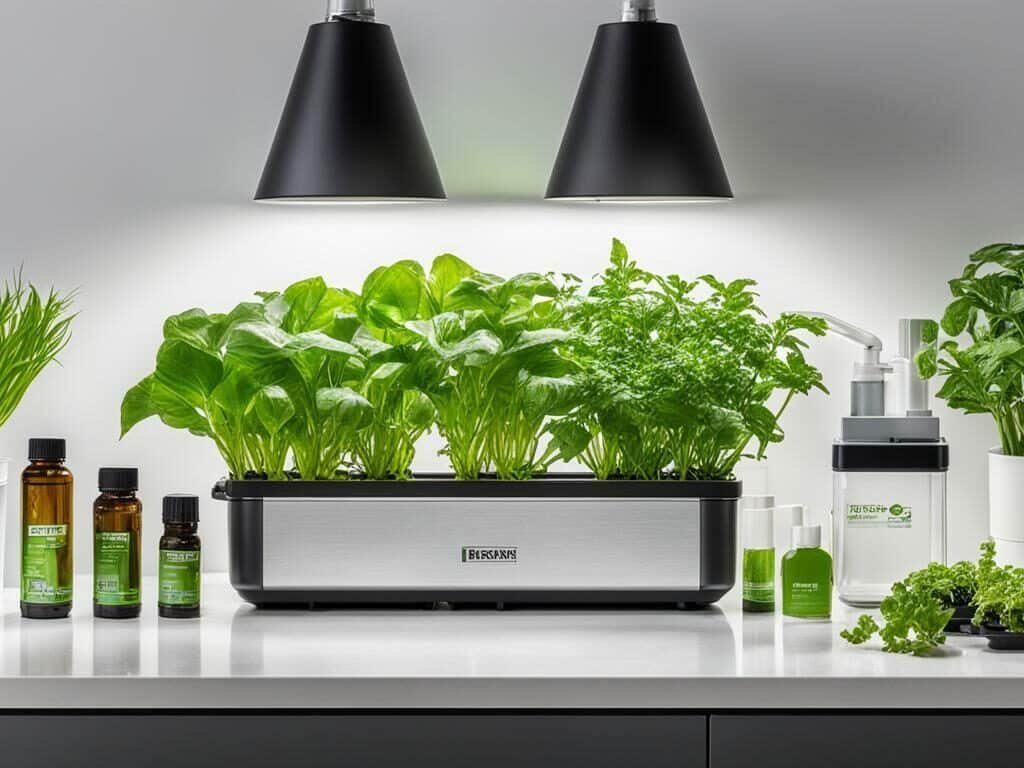
Remember to choose supplies that are appropriate for your space, budget, and the types of plants you want to grow. With the right equipment and care, your indoor hydroponic garden can thrive and provide a bountiful harvest.
Maintaining Your Indoor Hydroponic System
Proper maintenance and care are essential for the health and productivity of your indoor hydroponic system. By regularly monitoring and adjusting key factors, you can ensure that your plants receive the optimal conditions for growth.
Here are some tips for maintaining your indoor hydroponic system:
| Aspect | Recommendation |
|---|---|
| Water Quality | Use filtered or distilled water to avoid mineral buildup and contamination. |
| pH Levels | Regularly test and adjust pH levels to maintain a range of 5.5–6.5 for most plants. |
| Nutrient Levels | Monitor nutrient levels and adjust accordingly to prevent deficiencies or excesses. |
| Lighting | Ensure that your plants receive adequate lighting, adjusting the intensity and duration as needed. |
| Pest Control | Regularly inspect your plants for signs of pests or diseases, and take action promptly with appropriate treatments. |
Regularly cleaning your hydroponic system can also help prevent the buildup of algae, bacteria, and other contaminants that can negatively impact plant health and growth.
Incorporating routine maintenance into your indoor plant care routine will help prolong the lifespan of your hydroponic system and ensure that your plants continue to thrive.
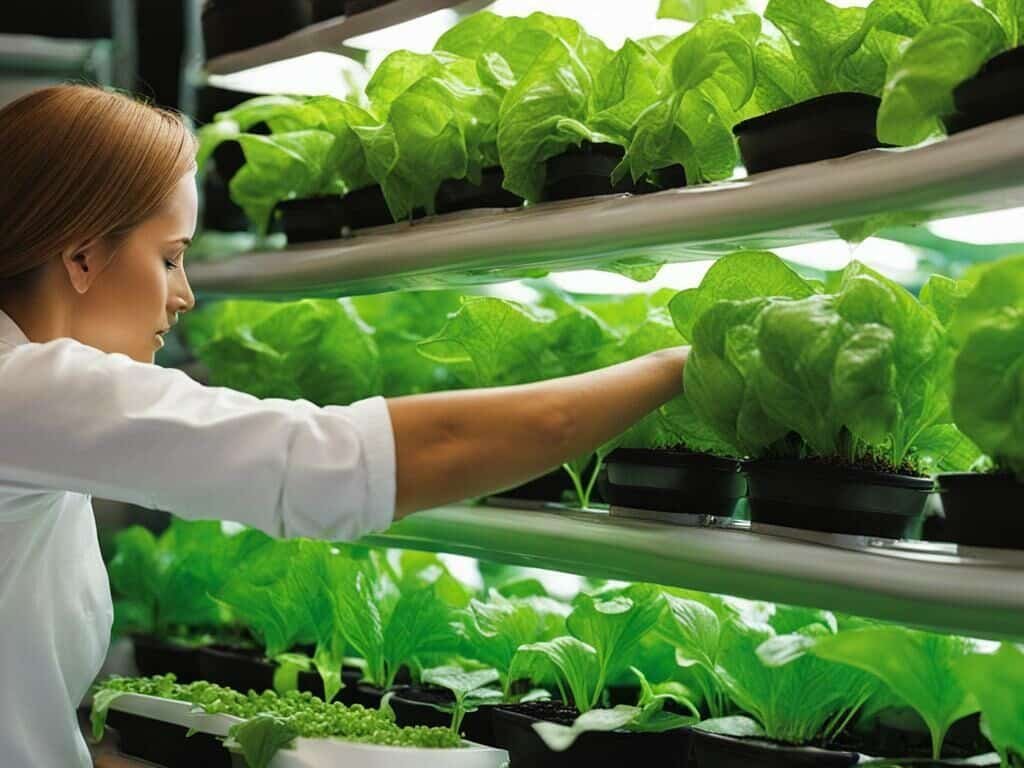
Troubleshooting Common Indoor Hydroponic Issues
While indoor hydroponics offers many benefits, it’s worth noting that it’s not without its challenges. Here are some common issues you may face with your hydroponic equipment, along with some troubleshooting tips:
| Problem | Solution |
|---|---|
| Pump failure | Check the power source and wiring. Replace the pump if necessary. |
| Nutrient deficiency | Adjust the nutrient balance and concentration. Ensure proper pH levels. |
| Algae growth | Reduce light exposure, improve circulation, and use an algaecide if necessary. |
| Pest infestation | Use organic pest control methods such as neem oil or insecticidal soap. Ensure proper sanitation and air circulation. |
By addressing these issues promptly, you can ensure the health and productivity of your plants and avoid any setbacks in your indoor hydroponic garden.
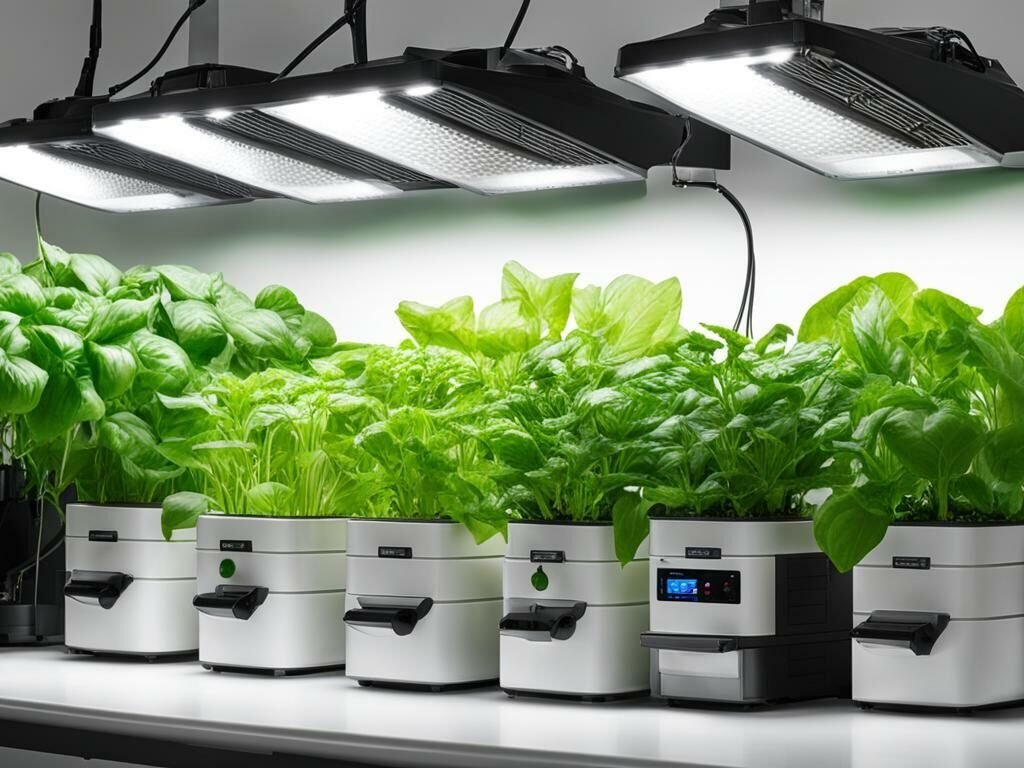
Expanding Your Indoor Hydroponic Garden
Now that you have successfully built and maintained your indoor hydroponic system, it’s time to think about expanding your garden and increasing your savings. There are several strategies you can employ to scale up your system and grow a wider variety of crops.
Diversify Your Crop Selection
One way to expand your indoor hydroponic garden is to diversify your crop selection. Experiment with different types of fruits, vegetables, and herbs that thrive in hydroponic environments. Some popular options include cherry tomatoes, strawberries, basil, and lettuce.
Consider the nutritional value and demand for each crop when making your choices. You may also want to rotate your crops to prevent nutrient depletion and soil-borne diseases.
Upgrade Your Hydroponic Equipment
To increase the productivity of your system, you may need to invest in more advanced hydroponic equipment. Upgrading to larger containers, more powerful grow lights, or automated nutrient delivery systems can help you grow more plants and save time.
However, make sure to do your research before buying any new equipment. Consider the cost-benefit analysis and ensure that you have the necessary skills and knowledge to use the new equipment effectively.
Sell Your Homegrown Produce
If you have surplus produce from your indoor hydroponic garden, consider selling it to your local community. Farmers’ markets, co-ops, and online marketplaces are great places to start. Selling your homegrown produce not only helps you recoup your expenses, but it also promotes sustainable agriculture and encourages others to try indoor hydroponics.
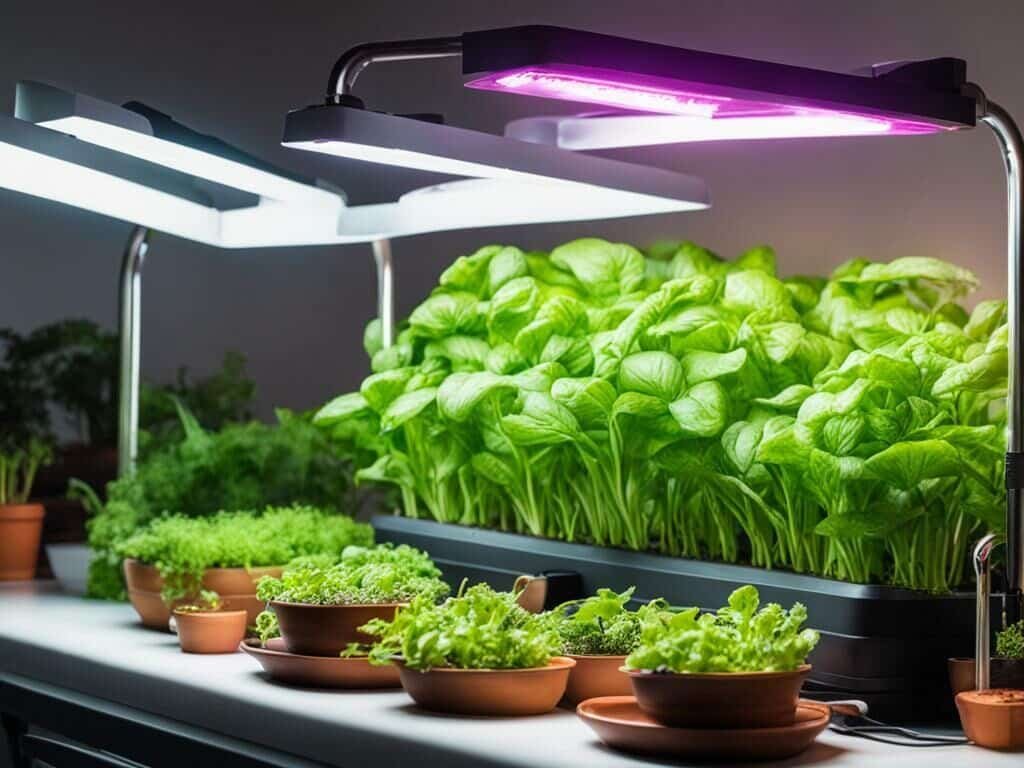
Expanding your indoor hydroponic garden takes time, effort, and investment. However, the rewards of self-sufficiency, cost savings, and environmental sustainability make it a worthwhile endeavor. Start small and gradually build your system to achieve optimal results. With the right equipment, crop selection, and marketing strategies, you can turn your indoor hydroponic garden into a profitable enterprise.
Incorporating Indoor Hydroponics into Your Lifestyle
Indoor hydroponic gardening is not just a way to save money on groceries; it can also become a fulfilling hobby and lifestyle. By growing your own produce, you are not only providing yourself with fresh and healthy food but also gaining a sense of control and self-sufficiency in your life. Here are some tips to help you incorporate indoor hydroponics into your lifestyle:
- Plan your meals around your harvest. As you start harvesting your own produce, plan your meals and recipes around what you have available. This will not only help you save money on groceries but also encourage creativity in the kitchen.
- Involve your family: Growing your own food can be a fun and educational experience for your family. Encourage your children to help you with the planting and harvesting, and teach them the importance of self-sufficiency and sustainability.
- Share your harvest. If you have an abundance of produce, consider sharing it with your friends and neighbors. This can help build a sense of community and introduce others to the benefits of indoor hydroponics.
- Experiment with new crops: Indoor hydroponics allows you to grow a wide variety of crops, including those that may not be available at your local grocery store. Try growing exotic fruits or vegetables to expand your culinary horizons.
By incorporating indoor hydroponics into your lifestyle, you can not only save money but also gain a sense of pride and satisfaction in growing your own food. With a little bit of effort and some careful planning, you can reap the rewards of this sustainable and cost-effective gardening method.
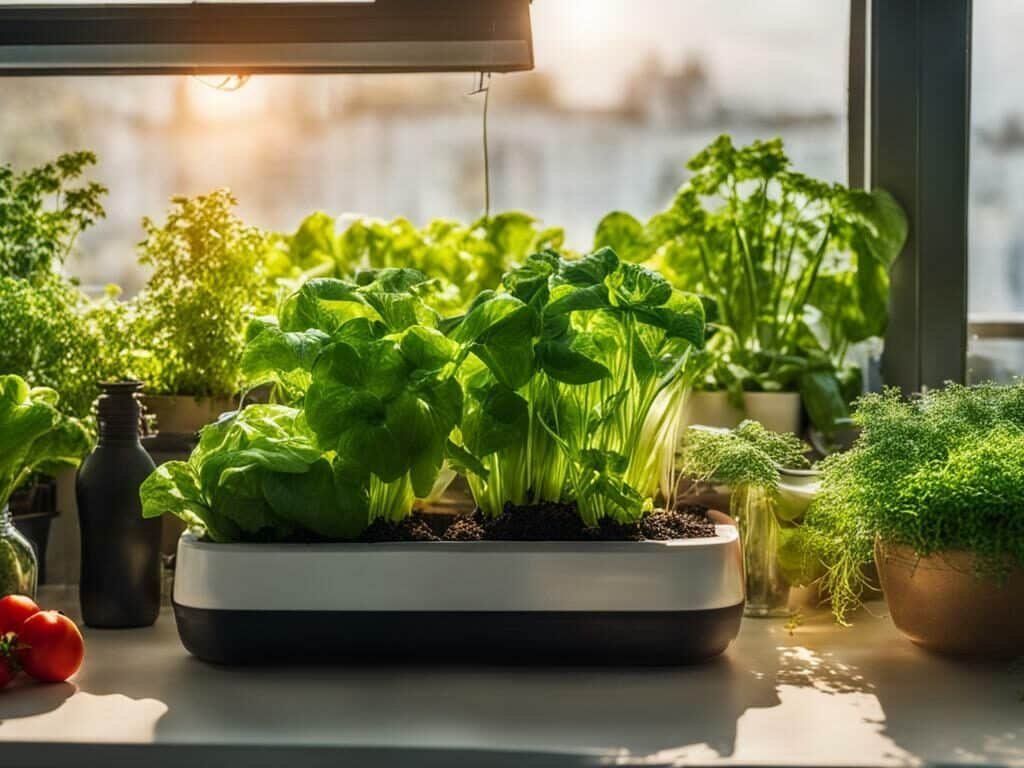
Conclusion
Indoor hydroponics is a game-changer for anyone who wants to save money and enjoy fresh, delicious produce year-round. From herbs and leafy greens to tomatoes and strawberries, indoor hydroponic gardening can help you grow a wide variety of crops in the comfort of your own home.
By following the guidelines and tips outlined in this article, you can set up and maintain a productive and sustainable hydroponic garden. Start with a small system and scale up as you gain experience and confidence.
With the right hydroponic supplies, nutrients, and maintenance, you can enjoy a bountiful harvest and reduce your grocery expenses. Plus, the satisfaction of growing your own food and incorporating it into your daily meals is priceless.
Taking the First Step
If you’re ready to get started with indoor hydroponic gardening, there’s no time like the present. With a little research and planning, you can set up your own hydroponic system and start reaping the benefits. Don’t let the technology or the science intimidate you; indoor hydroponics is accessible and affordable for anyone who wants to try it out
Remember, indoor hydroponics is not only a way to save money; it’s also a way to connect with nature, learn new skills, and take control of your own food supply. So, why not give it a try? We can’t wait to see what you grow!
FAQ
How does indoor hydroponics help save money?
Indoor hydroponics eliminates the need for soil and allows for precise control of nutrient levels, resulting in faster and more efficient plant growth. This means you can produce higher yields in a smaller space, reducing the need to purchase produce from the store and saving you money on groceries.
What are the benefits of using indoor hydroponic systems?
Indoor hydroponic systems offer several advantages, including year-round growing, no need for pesticides or herbicides, and the ability to grow a wide range of crops. They also use less water compared to traditional gardening methods, making them environmentally friendly and cost-effective.
How do I get started with indoor hydroponics?
To start with indoor hydroponics, you’ll need to choose a suitable location, set up the necessary equipment such as grow lights and containers, and provide the optimal conditions for plant growth, including the right nutrients and pH levels. It’s also important to select the right hydroponic system based on your space and needs.
What hydroponic nutrients are essential for healthy plants?
Essential hydroponic nutrients include nitrogen, phosphorus, and potassium (NPK), as well as secondary nutrients like calcium and magnesium. Micronutrients such as iron, zinc, and manganese are also important for plant health. It’s important to provide the right balance of nutrients to prevent deficiencies and promote vigorous growth.
How do I choose the right hydroponic supplies?
When choosing hydroponic supplies, consider factors such as the size of your indoor garden, the type of crops you want to grow, and your budget. Essential supplies include grow lights, hydroponic systems, containers, pumps, timers, and nutrient solutions. Research different brands and read reviews to ensure you select high-quality and reliable supplies.
How do I maintain my indoor hydroponic system?
Regular maintenance is crucial for the success of your indoor hydroponic garden. This includes monitoring pH levels, checking nutrient levels, cleaning and sterilizing equipment, preventing pests and diseases, and ensuring proper water and nutrient circulation. Regular inspections and adjustments will help keep your system running smoothly and your plants healthy.
What are some common indoor hydroponic issues and how can I troubleshoot them?
Common issues in indoor hydroponics include pH imbalances, nutrient deficiencies, algae growth, and equipment malfunctions. To troubleshoot these problems, you can adjust pH levels, replenish nutrient solutions, provide adequate ventilation and lighting, remove any algae, and check for clogged or faulty equipment. Identifying and addressing issues early will help maintain a thriving garden.
How can I expand my indoor hydroponic garden?
To expand your indoor hydroponic garden, you can scale up your system by adding more trays or modules, increasing the number of grow lights, and expanding your crop selection. You can also consider selling your homegrown produce or sharing it with friends and family to maximize the benefits of your indoor hydroponic setup.
How can indoor hydroponics be incorporated into my lifestyle?
Indoor hydroponics can be integrated into your lifestyle by incorporating homegrown produce into your meal planning and recipes. It offers the satisfaction of knowing where your food comes from and the pride of growing it yourself. It’s a sustainable and rewarding way to embrace self-sufficiency, save money, and enjoy the freshest and most nutritious produce.


